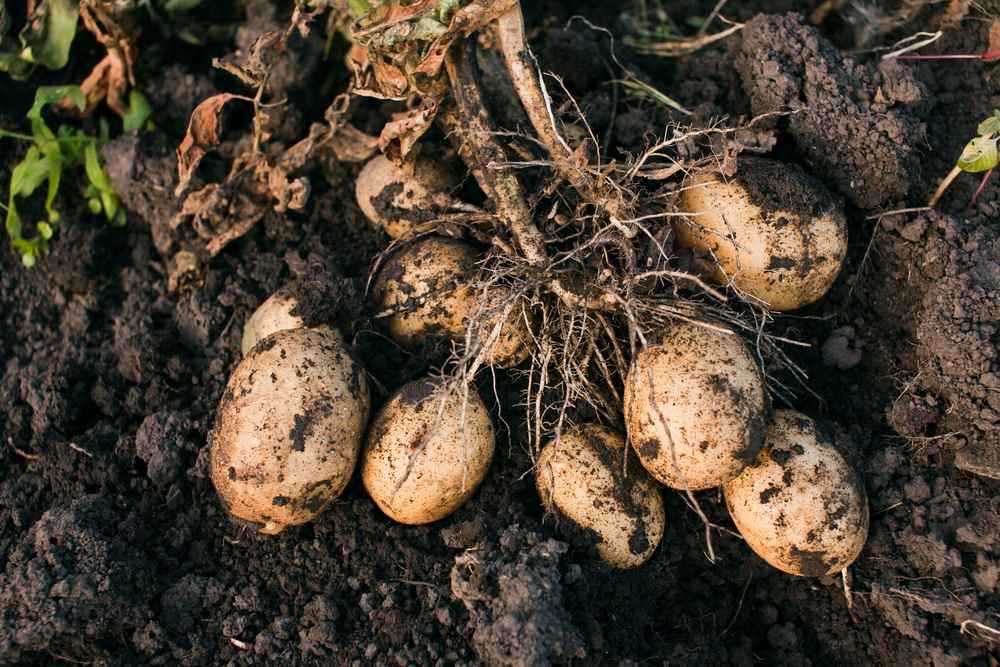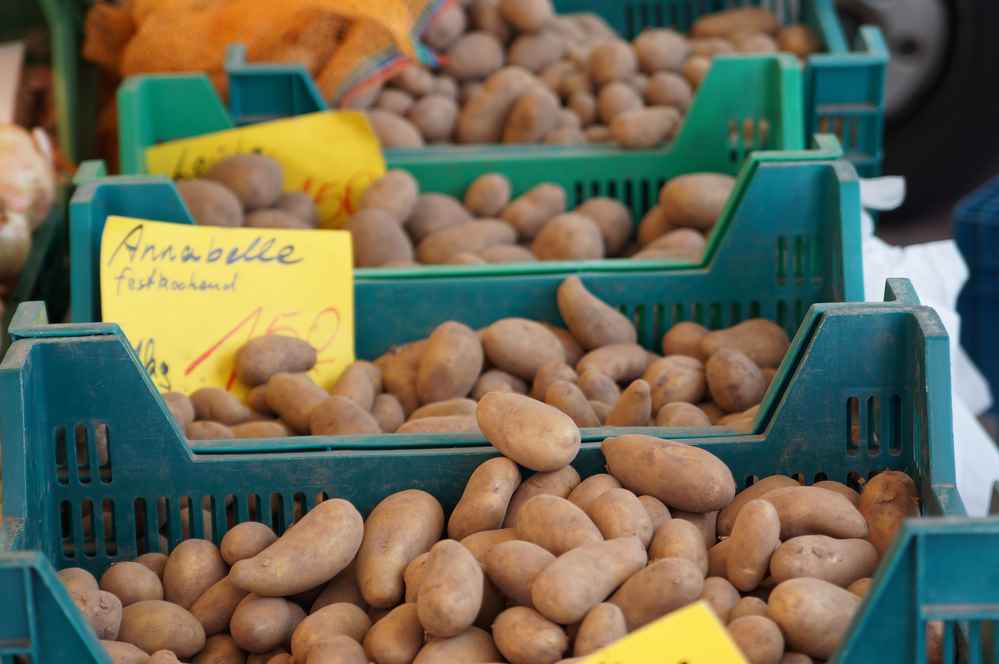The potato in Germany…it’s been a central part of the diet for so long, that it seems like it’s always been there. Mashed, boiled, fried, formed into Klöße, baked into bread… They might turn up at every meal. We had a bin in our kitchen JUST for potatoes! But considering how widespread the potato is, the Erdapfel is a relatively new addition to the German menu, and the acceptance of the lowly Kartoffel started off slowly. People looked at them with distrust… and a bit of fear since the berries are poisonous (many found out the hard way).
So… how did the potato go from possibly dangerous foreign import to Pancakes? Did Frederick the Great introduce Potatoes to Germany like the legend says?
“Potatoes make French fries, chips and vodka. It’s like the other vegetables aren’t even trying.“
How did the Potato Get to Germany?
In the mid-16th century, Spanish explorer Gonzalo Jimenez de Quesada went to the New World seeking gold. Instead of riches, after 9 months of trekking through the jungles, he came home with a shipload of Papas… the Inca word for Potato. (It’s said that Gonzalo Jimenez de Quesada’s obsession for gold made him the muse for Cervantes’s “Don Quixote’s”, making me wonder if the explorer ever had the opportunity to taste the golden deliciousness of perfectly crisped, lightly salted, Pommes.)

It was the Spanish who first ate potatoes in Europe, and they spread the crop in an interesting way. As their armies moved around the continent for war, they planted potatoes. The idea was to insure that there would be food for the guys coming up behind them, and something for the way back home. (Sort of like how they left pigs on tropical islands around the world). Grain would be trampled and needed watching, but potatoes would be safe underground (THIS! The fact that potatoes grow under the soil, is hugely important, we will circle back, I promise.) Local peasants saw that the Spanish armies were always fed, and figured out to dig up the potatoes… then either ate them, or fed them to the animals.
The problem is, besides the Spanish Army, not many people in Europe really knew what to do with potatoes. Fashionable women wore the pretty star-shaped flowers in their hair. Queen Elizabeth of England was given some, and her cooks threw the tubers away then cooked the poisonous leaves, stems, and flowers (that must have been one HECK of an international incident). And in Bavaria, they were planted in the royal gardens as an ornamental, until an American, Benjamin Thompson- Count of Rumford, showed up, and created the “potato based Pauper soup” for the inmates in Munich’s poorhouse, The House of Industry. (you can find the recipe here) (and the story about Benjamin Thompson here)
FUN POTATO FACT
South American Potatoes grew to a good size (sort of what we see now). But when people planted the tubers in Europe, the resulting potatoes were tiny, cherry sized things. Turns out, the growth of potatoes is dependent on sunlight. But, within a few years, the potatoes started growing BIGGER. Apparently, there was a genetic mutation along the way. Scientists studied the DNA of European vs South American potatoes… same potatoes, different gene structure. (To quote Jeff Goldblum from Jurassic Park “Life Finds a Way”). And that’s good for us, because no one wants teensy potato chips.
And this is where the story of how Potatoes came to be food in Germany gets a little fuzzy.

One legend says that The Great Elector Frederick William saw the potato plants in the Bavarian gardens, and brought them back to Prussia as an ornamental.
But…
Digging a little deeper into the history books, it seems that his wife, Luise Henriette of Orange-Nassau (in the Netherlands) brought Potatoes with her when she married him. They were planted in the Castle gardens of Oranienburg in Brandenburg. (She loved the village of Bötzow so much, that it was given to her as a present and renamed Oranienburg… she really disliked her husband, so a village with potatoes was her consolation prize). So… how did a royal woman from the Netherlands learn about potatoes? Remember, from 1579 to 1713, the area was controlled by Spain, and called the Spanish Netherlands.
(Small aside…I love these little historic tidbits. Liking potatoes and understanding successful potato cultivation methods are too different things, and honestly, I don’t see Luise Henriette getting her royal hands dirty, so who was growing the potatoes? Quite possibly, the Mennonites! In 1598 French King King Henry IV signed the Edict of Nantes, granting Protestants the right to worship as they pleased in Catholic France. The Mennonites set up farms in the Alsace Loraine. They were latecomers to France, and given whatever land was left. Marginal soil meant they got good at Potatoes. When the Edict was revoked in 1685, Protestants were given 2 weeks to convert or leave France. Among others, the Great Elector Frederick William offered them a place to live in Brandenburg …so the Mennonites left France, taking their potato knowledge with them.) (Coincidentally, William Penn sent out Marketing Materials for his Pennsylvania colony in 1685… in them he mentions how Pennsylvania is a great place to grow potatoes….)
It’s also during this time (1682) that Wolf Helmhardt von Hohberg published his Georgica Curiosa. The multi-volume text details how to run a landholding, along with instructions on planting, growing, harvesting, and cooking multiple plants… including the potato. His recipe for “Erd-Apffel Warm und Kalt Zurichten” (Potatoes, warm and cold preparations) is considered to be the FIRST German Potato Salad recipe.

And now… back to Prussia.
Frederick the Great and the Potato
King Frederick II, King of Prussia and Elector of Brandenburg (and great grandson of Great Elector Frederick William) aka. Frederick the Great, (Old Fritz and Alte Fritz) wanted the people to eat potatoes, partially because grain was so fragile under a marching army’s boots. According to legend, he planted a special fields of potatoes around Berlin, and had armed guards posted to protect them. Rumors were spread that this field contained a special crop of delicious potatoes, and that they were scarce, and only fit for royalty. Then he told the guards to be less than vigilant… to take naps… to look the other way when locals dug up some of these “special potatoes” to eat.
The truth contains fewer Tom Sawyer type shenanigans, but Old Fritz DID begin a marketing campaign to spread the Potato across Prussia.
During the Austrian War of Succession (1740-1748) Frederick the Great realized that dependance on a single grain crop could lead to disaster during wartime, or bad growing years. Both for peasants and his armies. Grain and bread just didn’t work well as provisions for an army on the move. Think of the logistics, soldiers were given a bread ration of 1 Kg (2.2 pounds) of bread per week. Bread does not travel well… it goes goes stale or moldy. The armies carried grain instead. So now the math problem- It takes 100 kg of grain to grind 75 Kg of flour (although, I imagine they would leave the waste in at that time). When baking, 75 Kg of flour, gets you 100 kg of bread. And you needed someone to grind, mix, rise, and bake the bread. Potatoes needed far less effort (You could even drop them into coals without peeling!) and their caloric value was 3.6 times that of wheat. They may not have tasted great without seasonings and butter, but they were incredibly nutritious.
Despite this, getting farmers to plant potatoes took some convincing. In Prussia, farms fell under strict regulations regarding crop cycles and crop rotation. Fields were divided into three parts… one for winter crops, one for fall crops, and the third would lie fallow (unplanted). The next year it would rotate. In this way, one field was always left to recover after two years of crops. Depending on the area, they would grow wheat, rye, oats, or barley. The system, in use for years, just didn’t have space for another type of crop.
Besides, potatoes could grow in almost any soil. The fields in Central Europe were perfect for grain, why waste it a crop no one liked? Potatoes were fine for animal fodder, but not for people!
But Frederick persisted! Like the Spanish Army years before, Frederick the Great had seedling potatoes spread to peasants with instructions for planting. And it worked. His peasants didn’t starve. And his armies may have grumbled about the cuisine, but they didn’t starve either.

Robert Müller, Der König überall Public domain, via Wikimedia Commons
During the Seven-Years war (1756-1763) when the French blockage prevented imports of grain, it was the potato that prevented famine. And the War of Bavarian Succession (Frederick the Great’s last war, 1778-1779) got its nickname “the Potato War”, because the soldiers did more foraging for potatoes than actual fighting…. the war ended when the potatoes ran out.
To this day, people thank Frederick the Great by leaving a potato on his grave at the Palace of Sansoucci.

Erd-Apfel Becomes an Essential Food Source and a Gets a Name
Potatoes rapidly gained importance as a food source. After the Seven Years War, around half of the population was eating potatoes regularly. The eruption of the Indonesian Volcano Tambore in 1815 caused a year with no summer, which led to grain shortages and famine. Potatoes filled the gaps. And in 1819 the Erd-Apfel was finally distinguished from other tubers and root vegetables, and were given their own name- Kartoffel. (Before this …all root veggies were called Erd-Apfel).
By the 1840s potatoes were fueling the German Industrial Revolution. Potatoes were cheap and filling. According to Ursula Heinzelmann in Beyond Bratwurst, the poor were eating potatoes 2-3 times a day. They grew in poor soil, and were easy to cook. You could bake or boil them, or just drop them into a soup. Plus, they could be distilled into Schnapps, which (along with coffee) kept the masses happy and working.
Once people started cooking with Kartoffel regularly, they started making them delicious.

Potato Kartoffel….
Today, the Potato is a staple part of the German diet! The average German eats 57 KILOS – that’s 125 pounds– of potatoes a year! Why not? Potatoes are healthy with almost no fat, and more vitamin C than an apple.
With over 360 varieties registered there, you will find the right potato for every usage. But how? Fortunately, Potatoes get classified by a few criteria…
1. When they are harvested; early in the year, late spring, early summer, or autumn. The earlier the potato, the thinner the skin…so they are great for (among MANY other things) Pell Kartoffel (little potatoes boiled in their skin, and served at the table with a paring knife).
2. By their texture when cooked; floury or waxy. Festkochend or waxy potatoes hold their shape, and are perfect for potato salad… Mehlig or floury will fall apart on you, so use them for mashed potatoes. And in the middle is the workhorse of potatoes, the Vorwiegend festkochend, which basically means sort of waxy, sort of floury. These can be cooked into most dishes…not too dry, not too mushy.
Potatoes are an astonishingly versatile food! You can make family favorites like Kartoffelpuffer (Potato Pancakes), Klöße (Potato Dumplings), Boiled Potatoes, and Stampf Kartoffel (Mashed Potatoes). German home favorites like Kartoffeln mit Quark und Leinöl (potatoes with Quark and Flaxseed oil), and Pellkartoffel (potatoes boiled in their skin). Potatoes turn up in Eintopf (one pot meals) to stretch the hearty flavors. Every Omain Germany swears by a different recipe for Kartoffelsalat (Potato Salad), hot and cold And we certainly can not forget… the Pommes (Fries), the focus of all those late-night Imbiss runs (Mit oder Ohne Mayo? With or without Mayonaise).
So, thank you Gonzalo Jimenez de Quesada. You may not have found your gold mine, but you brought back something even more important…. The Potato..

Resources
Beyond Bratwurst- Ursula Heinselmann , Reaktion Books
How the Potato Changed the World- Charles C. Mann, Smithsonian Magazine
How did potatoes adapt to Europe? By Tammana Begum Natural History Museum 2 August 2019
Germany- Potato Country – Alumniportal Deutschland
Rumsford’s Soup – British Food in America
ORDER, INDUSTRY, VIRTUE: COUNT RUMFORD AND EIGHTEENTH CENTURY EUROPEAN POOR RELIEF Pat E. McQueen B.A., Honors, Simon Fraser University, 1995


